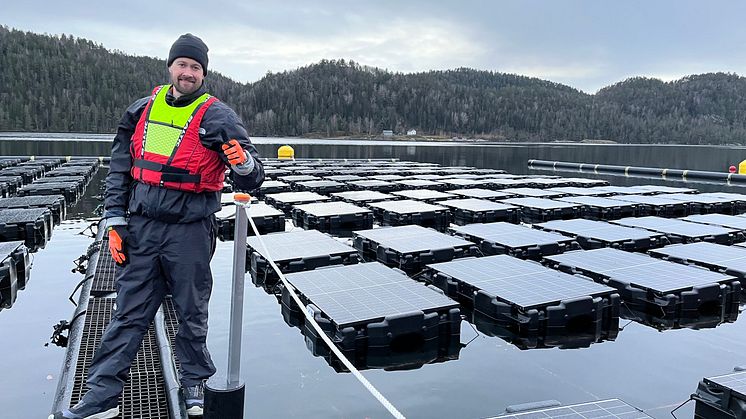
Blog post -
Upgrading Floating Modules on the Pilot of BRIZO: An Interview with Our Project Manager
Our BRIZO pilot project in Risør, Norway, recently underwent an important technical upgrade where all floating modules were replaced with newly designed, blow-molded versions.
The pilot site in Risør serves as a dynamic testing ground, where we bring our engineering concepts to life through real-world implementation. But what does a day replacing all floating modules at our BRIZO site look like?
We have asked Christian Petterson, our Project Manager for our pilot project of BRIZO in Risør, to describe a working day on site. He plays a pivotal role in ensuring the seamless execution of the project.
-Could you walk us through the process of turning engineering ideas into reality at Risør? How does it all come together?
"The time from idea to execution is quite short. Our process involves scheduled improvements and product development, alongside ad hoc ideas and solutions to solve challenges and test ideas. The overarching goal is always to learn and improve as quickly as possible.
Our pilot site in Risør serves as a testbed for these efforts. The engineering team develops an idea, that we want to prototype and test out as soon as possible.
The floating module replacement showcased in the video required collaboration with partners in the plastics industry and blow-molding specialists to ensure the success of the design iteration. Our partners’ expertise also contributes valuable input for future designs, while expanding and strengthening our in-house knowledge base.
Ideally, the engineers start by creating a basic design based on a detailed list of specification requirements. In parallel, I typically identify potential suppliers and plan the operation in coordination with the site manager. Once the specification requirements are in place, I begin sourcing materials and coordinating the operation. However, the process is rarely this linear. As a lean and dynamic team, we are fully invested in all stages of the development of BRIZO.
To streamline operations, we plan them in parallel with the engineering and procurement processes, ensuring we are ready to proceed as soon as materials arrive on site. Our experienced site manager, supported by a skilled team, ensures seamless execution of operations."
-Your job is to bridge the gap between engineers in the office and the crew on site. Can you describe how you manage that dynamic?
"The role involves spending significant time on the phone, acting as a bridge between the office and the crew on site, and vice versa to communicate and address concerns effectively.
It is very beneficial to be able to test out engineering ideas from the office on-site as fast as possible. Being able to test the practical implementations head-on – such as issues with storage, lifting, or handling – is crucial for the development of the technology to work not only on paper but on a commercial scale."
-Can you describe a typical workday for you and the crew at the Brizo site in Risør? Specifically, what did a day look like when you carried out the floating module replacements?
"There is no typical workday on site, as BRIZO is a brand-new technology. However, while we installed floating modules last year in Risør using different techniques, this was the first time utilizing the O&M catamaran. The process involved closely following established procedures, ensuring proper assembly, correct connections, and safe transportation of the components.
A usual day on site starts early in the morning with the site manager, arriving by boat. The day begins with a toolbox talk, reviewing the planned tasks’ potential risks, and mitigation strategies - safety is our highest priority. The day is a mix of executing the planned tasks and adapting to practical feedback. The site manager, being highly hands-on, provides corrections and suggestions to ensure tasks are completed as efficiently and practically as possible.
A critical part of the process is remaining open to new learnings, adapting based on the on-site situation, and then refining methods to ensure the best possible outcomes.
Having someone from the office present during key activities is invaluable. This allows us to capture and document lessons learned and gather insights that inform the next pilot project, ensuring continuous improvement. Hands-on experience is essential for the team, as it builds in-house expertise and fosters a deeper understanding of the technology and processes."
-What is the next step in terms of upgrading BRIZO in Risør?
"The next steps involve applying the upgrades and knowledge gained from this year’s work. This systematic approach will guide the next iteration of the BRIZO concept. This is supported by the collection of data from the Risør pilot to learn how energy production, system motions, and forces relate to the environment. This information will be used to further optimize system layout and components:
The data being collected includes:
- Power production from each string.
- Motion tracking of the floater and PV panels to analyze their behavior.
- Temperature readings on the PV panels.
- Forces in the mooring lines, the main rope mesh, and the ropes connected to each individual floater and PV panel.
- Environmental data from the weather station, which records temperature, precipitation, cloud cover, wind, and currents, as well as information from two wave buoys.
The next major step is the deployment of a commercial-sized 3 MW system."
Thank you to Christian Petterson for guiding us through the processes that turn engineering ideas into reality. The insights have provided a clear view of how engineering work evolves into real-life tangible concepts in Risør.
Learn more about BRIZO here.